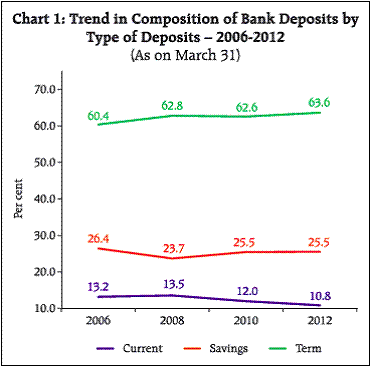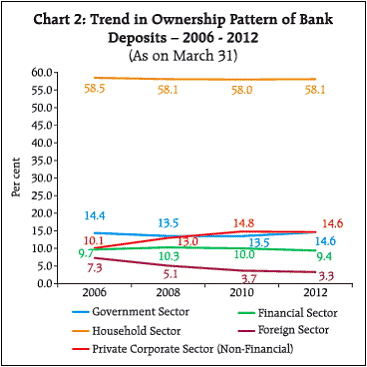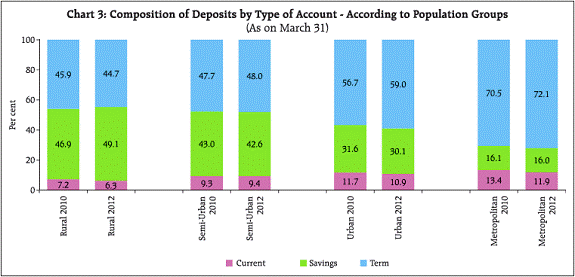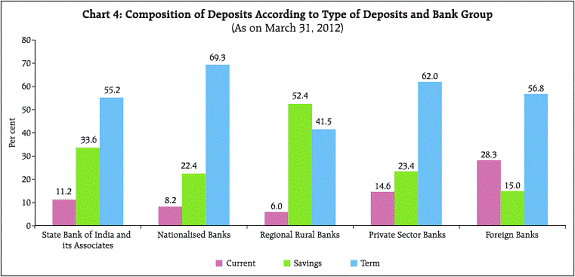Composition and Ownership Pattern of Deposits with Scheduled Commercial Banks: March 2012 - ଆରବିଆଇ - Reserve Bank of India
Composition and Ownership Pattern of Deposits with Scheduled Commercial Banks: March 2012
Composition and Ownership Pattern of Deposits with Scheduled Commercial Banks: March 2012* This article presents an analysis of pattern in composition and ownership of outstanding deposits with scheduled commercial banks (including regional rural banks) during 2006-12. For this purpose, the data on ownership pattern of deposits as estimated from sample survey data for the period during 2006-10 is used along with the census survey data as collected for end-March 20121. The analysis brings out broad trends across type of deposit accounts, institutional sectors, population groups and bank groups over the period. Highlights • Current, savings and term deposits comprise 10.8 per cent, 25.5 per cent and 63.6 per cent, respectively of total deposits in March 2012. The share of term deposits regained a rising trend after March 2010. • Households with 58.1 per cent share in total deposits was the largest contributor in total deposits as on March 31, 2012, followed by government and private corporate sector each contributing 14.6 per cent. • Metropolitan branches continued to lead deposit generation by scheduled commercial banks (SCBs) mainly in the form of term deposits. Similar pattern was followed in deposits raised by urban and semi-urban branches. On the contrary, savings deposits dominated in rural branches closely followed by term deposits. • Bank group-wise, public sector banks accounted for the largest share (74.6 per cent) in total deposits in March 2012 followed by private sector banks (18.2 per cent). Foreign and regional rural banks (RRBs) comprised only 4.3 per cent and 2.9 per cent in total deposits, respectively. Introduction The statistics on ownership pattern of deposits are compiled from the branch level data reported by the SCBs through Basic Statistical Returns (BSR)-4. It captures the data on ownership of outstanding deposits as on March 31, classified according to type of deposits accounts namely, current, savings and term deposits as per different institutional categories of depositors (i.e., Household, Government, Private Corporate (Non- Financial, Financial and Foreign). These data also help to analyse the trends across population groups and major bank groups (public sector banks, private sector banks and foreign banks). 2. So far, similar data used to be collected for selected sample branches (15-27 per cent of total branches) using stratified sampling method to arrive at estimates of various population aggregates. Due to expanding branch network of commercial banking with the thrust on financial inclusion, it was thought appropriate to undertake a census study on ‘Composition and ownership pattern of deposits of SCBs’ to validate as well as understand the recent changes in institutional shares in bank deposits in the recent period. Accordingly, the March 2012 survey has been carried out on a census basis and the results are found to be in agreement with previous estimated trends since 2006. The branch-wise data on outstanding aggregate deposits are also validated against outstanding aggregate deposits data reported in the quarterly BSR-7 for March 31, 2012. 3. This article presents a brief review of the trends and pattern in type of deposits accounts (current, savings and term deposits). Ownership pattern of deposits by broad institutional sectors has been analysed followed by the section on the pattern of deposits according to population groups. Subsequently, bank-group wise analysis on preference of various institutional depositors is discussed. A brief on statewise pattern in bank deposits as on March 31, 2012 is also added. Composition of Bank Deposits by Type of Deposits 4. Composition of total deposits2 held with the SCBs as on March 2012 indicates that the term deposits constituted around two-thirds share in total deposits, followed by savings deposits at around one-fourth share (Chart 1). 5. The share of savings deposits was maintained at around 25.5 per cent in the recent period along with a moderate growth in the share of term deposits. On the contrary, the share of current account balances declined from 2008 onwards, portraying somewhat cautio saving behaviour among the different types of depositors. 6. Though, the total deposits along with its three main components almost trebled during 2006 to 2012, total deposits decelerated 2007 onwards (Table 1). The growth and composition of deposits also appear to have a correspondence with the prevailing term deposit rates. There was a sharp growth in savings deposits by the end-March 2010 (31 per cent as compared to 17-21 per cent observed in the preceding four years) and corresponding decline in growth in term deposits as against somewhat lower term deposits rates. With the increase in interest rates during 2010-12, the term deposits started improving moderately.
Ownership pattern of deposits by broad institutional sectors 7. Composition of deposits according to institutional ownership reflected dominance of households, who owned an almost constant share in total deposits to the tune of around 58 per cent over the period (Chart 2). Share of non-financial private corporate in total deposits, by and large, grew steadily from 10.1 per cent to 14.6 per cent during 2006-12, whereas the shares of government as well as financial sector remained range bound at 13.5-14.6 per cent and 8.9-10.5 per cent respectively. Foreign sector’s share declined to almost half of the share as on March 31, 2006 (7.3 per cent). In the recent period of 2010-12, the growth of 1.1 per cent in the government sector’s share was mainly on account of higher growth in deposits of departmental undertakings and public sector corporations. Financial entities’ share declined mainly on account of lower growth in inter-bank deposits (Table 2).
8. Within households, individuals (including Hindu Undivided Families-HUFs) comprised largest share ranging 77-80 per cent of total deposits followed by proprietary and partnership firms (5-6 per cent) and trusts and associations (3.5-4.6 per cent) during the period 2006-12 (Table 3). 9. The institutional ownership composition of various types of deposits indicates that the households which is the largest holder of total deposits outstanding with SCBs, also held the largest shares across the three types of deposits, viz., current, savings and term deposits during 2010-12 (Table 4). More than 80 per cent of savings deposits and more than 50 per cent of term deposits are held by households. As regards current deposits, the non-financial private corporate sector was the second largest contributor followed by the Government sector during 2010-12. However, the share of non-financial private corporate sector in total current deposits declined during 2010-12 mainly in favour of financial sector. 10. Term deposits constituted major part of total deposits for all institutional sectors over the period 2006-12. Savings deposits were the second major constituent in all sectors barring non-financial private corporate and financial sectors, wherein current deposits were significant as compared to savings deposits (Table 5). Ownership Pattern of Deposits across Population Groups6 11. Distribution of total deposits across population groups wherein bank branches were located indicated that metropolitan branches contributed maximum in total deposits (56-58 per cent during 2007-12) followed by urban (20-22 per cent), semi-urban (13-14 per cent) and rural (8-10 per cent) branches (Table 6). The share of rural branches in total deposits, which declined during 2006-09, had started recovering thereafter. Further, deceleration in total deposits during 2010-12 had been mainly on account of deceleration in deposits raised by metropolitan branches.
12. Term deposits remained dominant across metropolitan, urban and semi-urban population groups followed by savings deposits during 2010-12 (Chart 3). However, in respect of deposits raised by rural branches, savings deposits constituted largest share, closely followed by term deposits. 13. Institutional sector composition revealed dominance of households sector in all population groups. Within households, individuals (including Hindu Undivided Families – HUFs) constituted largest share across all the population groups. The households accounted for more than 80 per cent of total deposits in rural and more than 70 per cent in semi-urban centres, however, their share was comparatively lower at around 45 per cent in metropolitan areas. Ownership Pattern of Deposits According to Bank Groups 14. Bank group wise, public sector banks (comprising SBI and its associates and nationalised banks including IDBI Bank) comprised the largest share in total deposits, which had continuously increased from 70.1 per cent as on March 31, 2007 to 74.6 per cent as on March 31, 2012 (Table 7). Domestic private sector banks comprised 3.5-4.3 times of the deposits held by foreign banks during 2007-12. The RRBs' share in total deposits was the lowest at around 3 per cent during 2007-12. 15. Distribution according to type of deposits in March 2012 was similar to earlier years. In 2012, SBI and its associates, nationalised banks and private sector banks followed the same pattern, where the term deposits had the largest share followed by savings deposits (Chart 4). In the case of foreign banks, term deposits constituted more than half of the total deposits followed by current deposits (more than onefourth). In the case of RRBs, savings deposits accounted for more than half of the total deposits followed by term deposits (around two-fifth).
16. Institutional ownership of deposits as on March 31, 2012 indicated that the households accounted for the highest share in total deposits in all bank groups barring foreign Banks, in whose case non-financial private corporate sector held the largest deposits (Table 8). 17. Selection of bank groups by various institutional players appeared to be based on flexibilities required for their business as well as the customer oriented business strategies of banks. While around 92 per cent of the Government deposits were with public sector banks, deposits by non-financial private corporate sector were distributed across all bank groups barring RRBs. Most of the household deposits, specially individuals (largest constituent of household sector) were with public sector banks, possibly on account of comparatively bigger branch network of these banks. Institutional Ownership of Deposits According to States/Union Territories7 18. The composition according to ownership of deposits as at end March 2012 across different States/ Union Territories (UTs) shows the dominance of households sector’s savings in bank deposits with different degrees of variations. The overall households share in total deposits in the Central Region was the highest at 72.9 per cent with the corresponding States/ UT’s share varying in the range from 63 to 77 per cent, followed by the North Eastern States at 68.4 per cent with the constituents’ share being ranged between 63 to 75 per cent, the Eastern Region at 66.9 per cent (56 to 72 per cent), the Southern Region at 62.4 per cent (59 to 75 per cent). The households share in total deposits was lower in the Northern as well as Western Regions at 61.8 per cent (48 to 83 per cent) and 43.7 per cent (38 to 74 per cent) respectively, the variations being wider due to very low share of households in Delhi (47.9 per cent) and Maharashtra (38.0 per cent). The contribution of households in total deposits was above 75 per cent in seven States/UTs, namely Jammu & Kashmir, Punjab, Rajasthan, Uttar Pradesh, Dadra & Nagar Haveli, Lakshadweep and Puducherry. 19. In 20 States/UTs, the share of Government entities in total deposits was less than the all-India level. The share of non-financial private corporate sector in total deposits in six states namely, Maharashtra, Delhi, Uttarakhand, Andhra Pradesh, Karnataka, and Tamil Nadu was higher than the all-India level. Of the total deposits by non-financial private corporates, 81.5 per cent were in six states, namely, Maharashtra (41.9 per cent), Delhi (13.8 per cent), Karnataka (8.1 per cent), Tamil Nadu (6.4 per cent), Andhra Pradesh (6.1 per cent) and West Bengal (5.2 per cent). The share of ‘Foreign' sector deposits in total deposits was below 6 per cent in respect of 32 States/UTs. The ‘Foreign’ sector deposits accounted for 20.0 per cent, 16.0 per cent and 12.1 per cent of deposits in respect of Kerala, Daman & Diu and Goa, respectively. * Prepared in the Bank Branch Statistics Division of the Department of Statistics and Information Management. 1 More detailed data for March 2012 is available in the Reserve Bank website ‘URL:/en/web/rbi’. Previous findings from BSR-4 survey on Composition and Ownership Pattern of Deposits with scheduled commercial bank were published in various issues of Reserve Bank of India Bulletin; the latest was published in the November 2011 issue. The BSR-4 survey was made annual from March 1990, with the previous rounds being biennial from 1976 onwards; the surveys for 1976 and 1982 were on census basis. The data for March 2012 have been collected on a census basis as compared to previous rounds of sample surveys. 2 Includes inter-bank deposits. 3 March 2011 estimates based on stratified sampling method were not in alignment with the previous year estimates as also the latest census data for March 2012 and hence, not considered in the present study. 4 Excludes interbank deposits (Source: Quarterly BSR-7 return). 5 The term deposit rates for major banks (Source: Weekly Statistical Supplement, RBI). 6 The population group classification of banked centres is based on Census 2001 for surveys beginning 2006. For earlier surveys, classification was based on Census 1991. 7 More detailed data for March 2012 is available in the Reserve Bank website ‘URL:/en/web/rbi’.. |
||||||||||||||||||||||||||||||||||||||||||||||||||||||||||||||||||||||||||||||||||||||||||||||||||||||||||||||||||||||||||||||||||||||||||||||||||||||||||||||||||||||||||||||||||||||||||||||||||||||||||||||||||||||||||||||||||||||||||||||||||||||||||||||||||||||||||||||||||||||||||||||||||||||||||||||||||||||||||||||||||||||||||||||||||||||||||||||||||||||||||||||||||||||||||||||||||||||||||||||||||||||||||||||||||||||||||||||||||||||||||||||||||||||||||||||||||||||||||||||||||||||||||||||||||||||||||||||||||||||||||||||||||||||||||||||||||||||||||||||||||||||||||||||||||||||||||||||||||||||||||||||||||||||||||||||||||||||||||||||||||||||||||||||||||||||||||||||||||||||||||||||||||||||||||||||||||||||||||||||||||||||||||




























